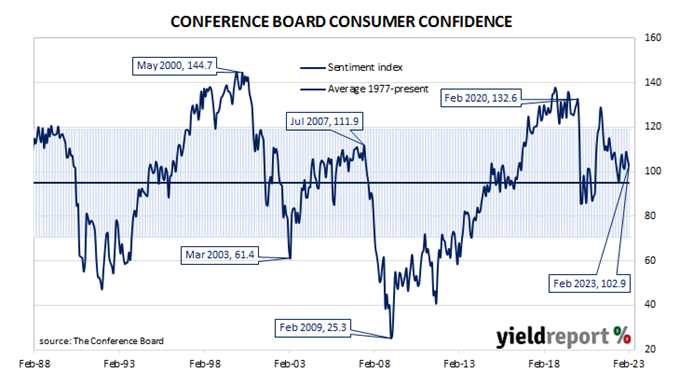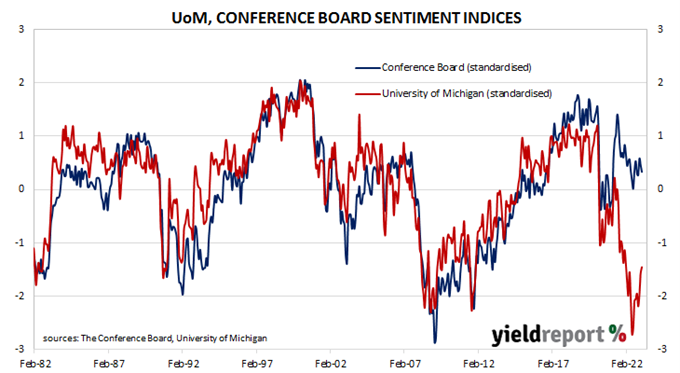Summary: Conference Board Consumer Confidence Index falls in February, reading less than expected; fewer consumers planning to buy major appliances, vehicle, houses; large drops in confidence for households aged 35 to 54, households earning $35,000 or more; views of present conditions improve, short-term outlook deteriorates again.
US consumer confidence clawed its way back to neutral over the five years after the GFC in 2008/2009 and then went from strength to strength until late 2018. Measures of consumer confidence then oscillated within a relatively narrow band at historically high levels until they plunged in early 2020. Subsequent readings then fluctuated around the long-term average until March 2021 when they returned to elevated levels. However, a noticeable gap has since emerged between the two most-widely followed surveys.
The latest Conference Board survey held during the first three weeks of February indicated US consumer confidence has deteriorated for a second month running. February’s Consumer Confidence Index registered 102.9 on a preliminary basis, lower than the expected figure of 108.4 and down from January’s final figure of 106.0.
“Expectations around jobs, incomes and business conditions all deteriorated. Fewer consumers are planning to buy major appliances, autos and houses,” noted ANZ economist Kishti Sen.
Short-term US Treasury yields moved moderately higher while longer-term yields held almost steady. By the close of business, the 2-year Treasury bond yield had gained 3bps to 4.82%, the 10-year yield had returned to its starting point at 3.93% while the 30-year yield finished 1bp lower, also at 3.93%.
In terms of US Fed policy, expectations of higher federal funds rates over the next 12 months remained essentially unchanged. At the close of business, contracts implied the effective federal funds rate would average 4.665% in March, 9bps higher than the current spot rate, and then climb to an average of 4.875% in April. May futures contracts implied a 5.11% average effective federal funds rate while December contracts implied 5.31%.
“The decrease reflected large drops in confidence for households aged 35 to 54 and for households earning $35,000 or more,” said Ataman Ozyildirim, a senior director of economics at The Conference Board.
Consumers’ views of present conditions improved while their views of the near-future deteriorated in a repeat of the previous month’s pattern. The Present Situation Index increased from January’s revised figure of 151.1 to 152.8 while the Expectations Index dropped from a revised figure of 76.0 to 69.7.
The Consumer Confidence Survey is one of two widely followed monthly US consumer sentiment surveys which produce sentiment indices. The Conference Board’s index is based on perceptions of current business and employment conditions, as well as respondents’ expectations of conditions six months in the future. The other survey, conducted by the University of Michigan, is similar and it is used to produce an Index of Consumer Sentiment. That survey differs in that it does not ask respondents explicitly about their views of the labour market and it also includes some longer-term questions.



